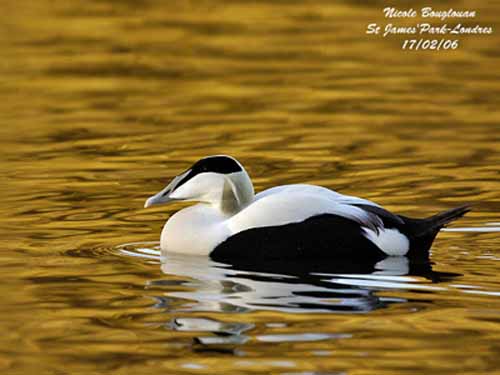
PROTECTION / THREATS / STATUS:
The Common Eider is widespread and can be locally abundant in suitable habitat. This species, and especially the ducklings, are preyed upon by Ravens and gulls in relatively great numbers.
However, several threats such as oil pollution, introduced mammals in nesting areas, degradation of breeding habitats, hunting and harvest of adults and eggs for consumption, and down for the trade, have caused several declines in Pacific races (S.m. v-nigra).
Thanks to the hunting regulation, the Common Eider has extended its breeding range in several regions.
In Iceland, where the eider down’s harvest in an important industry, the Common Eider is protected all year round against hunting.
Fr: Eider à duvet
All : Eiderente
Esp : Eider Común
Ital: Edredone
Nd: Eidereend
Sd: Ejder
Photographers:
Photographes:
Steve Garvie
RAINBIRDER Photo galleries
René Lortie
http://rlortie.ca
Nicole Bouglouan
PHOTOGRAPHIC RAMBLE
Texte de Nicole Bouglouan
Sources:
HANDBOOK OF THE BIRDS OF THE WORLD vol 1 by Josep del Hoyo-Andrew Elliot-Jordi Sargatal - Lynx Edicions - ISBN: 8487334105
ENCYCLOPEDIE DES OISEAUX DE FRANCE ET D’EUROPE – de Peter Hayman et Rob Hume - Flammarion – ISBN : 2082009920
GUIDE DES CANARDS, DES OIES ET DES CYGNES – de Steve Madge - Delachaux et Niestlé - ISBN: 2603013769
THE COMPLETE BOOK OF BRITISH BIRDS – Written by “Royal Society for the Protection of Birds” experts - Préface de Magnus Magnusson - Michael Cady- Rob Hume Editors - ISBN: 0749509112
THE HANDBOOK OF BIRD IDENTIFICATION FOR EUROPE AND THE WESTERN PALEARCTIC by Mark Beaman, Steve Madge - C.Helm - ISBN: 0713639601
BirdLife International (BirdLife International)
Hinterland Who’s Who - WILDLIFE IN CANADA
Eiders... four really strange ducks
Common Eider
Somateria mollissima
Anseriforme Order – Anatidae Family
BIOMETRICS:
Length: 50-71 cm
Weight: 1915-2218 g
DESCRIPTION:
The Common Eider is the largest duck in the northern hemisphere. Closely associated to marine habitats, this stunning duck is colonial and often seen in large flocks throughout the year.
Adult male in breeding plumage has white upperparts, wing coverts, head (except the crown), neck and breast, the latter with pinkish or pale orange wash.
Flight feathers are black, as rump, uppertail coverts and tail, and also underparts from belly to undertail coverts.

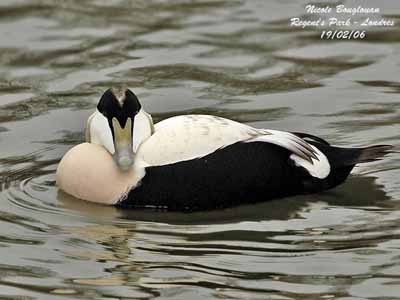
On the head, crown is black with white central stripe on head top. Black extends down to the eyes, lores and sides of the greenish shield.
During the breeding season, we can see a light greenish area on the rear neck and on the back.
The grey bill is large and wedge-shaped. Eyes are dark brown. Legs and webbed feet are pale greyish-blue.
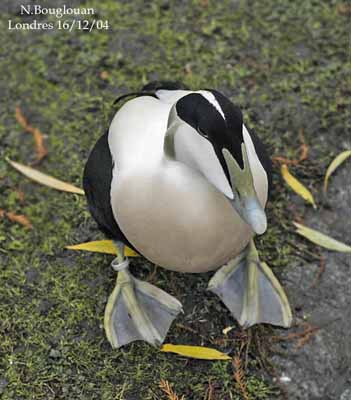
In eclipse plumage, the male is very dark with white areas on the upperparts and pale brown forehead and crown.

S.m. dresseri
Female is brown, from greyish-brown to reddish-brown. The body is entirely barred black. Flight feathers are blackish, as the tail.

The juvenile resembles female with finer black bars.
The male immature has white back and breast, black body and chestnut crown. It needs about 3-4 years to have the complete adult plumage.
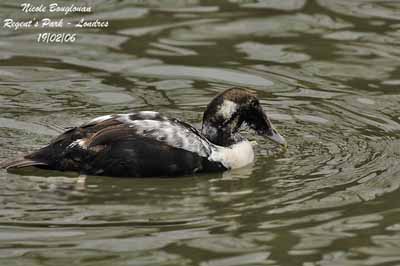
We can find six subspecies:
S.m. mollissima
S.m. faeroeencis has smaller bill and olive-grey frontal shield. Female shows darker barring.
S.m. v-nigra shows black V-shaped line on the throat.
S.m. borealis has grey-green bill from the nostrils to the nail, and orange frontal shield even in eclipse plumage.
S.m. sedentaria has smaller frontal shield. Female is paler and greyer than in other races.
S.m. dresseri has larger frontal shield than « sedentaria », but narrower than in other species. The facial skin reaches the eyes.
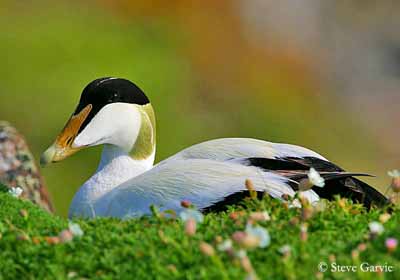
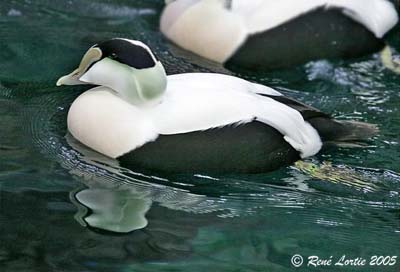
VOICE: SOUNDS BY XENO-CANTO
The Common Eider is more vocal during the breeding season while displaying. Male gives haunting and far-carrying calls over the water “ah ou ou”. The alarm call is a series of raucous “kor-korr-korr” notes.
Female is less vocal, producing series of throaty calls during the breeding season, and a “cluck-cluck-cluck” in defence of the chicks.
HABITAT:
The Common Eider frequents coastal waters and breeds on islands along the rocky coasts and the estuaries. This species may also be found inland, in tundra, pools and streams.
During the winter, the Common Eider is common in bays, along shallow seacoasts or river mouths. It rarely leaves the water, even in winter.
RANGE:
The Common Eider is found along the northern coasts of Europe, Eastern Siberia and North America.
This species breeds in Arctic regions, but populations are partially migratory and winter southwards in temperate areas such as N and NW Europe, Iceland, W Greenland, Hudson Bay, Labrador and NE North America, Alaska, Aleutian Islands and Kamchatka.
Usually, males remain more in northern regions than females and immatures.
BEHAVIOUR:
The Common Eider feeds by diving, head-dipping and upending, often in shallow water along rocky islands and coasts. This species feeds on molluscs, crustaceans and other marine invertebrates, and sometimes fish. The Common Eider eats slow-moving aquatic invertebrates by diving from the surface. It is able to swim underwater thanks to the feet. It feeds mainly at low tide, when molluscs are easier to reach, and in the morning and the evening.
However, when the female is incubating at nest, she feeds several plant items such as algae, berries and seeds, and some leaves close to the nest-site.
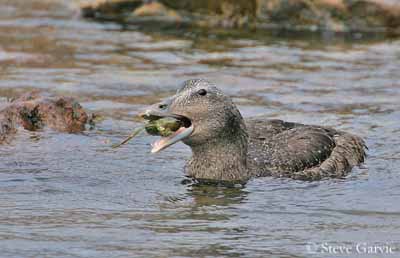
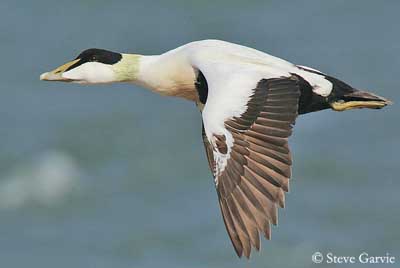

REPRODUCTION:
Breeding season starts in April-May, and later in the northern parts of the range.
The Common Eider often breeds on small offshore islands or isolated places, free of terrestrial predators such as mammals. Both birds perform prospecting flights in order to select a nest-site. They may use the same site for several years or choose a new one.
They nest in dense colonies of tens to 10 000 and more. They produce only one brood per season.
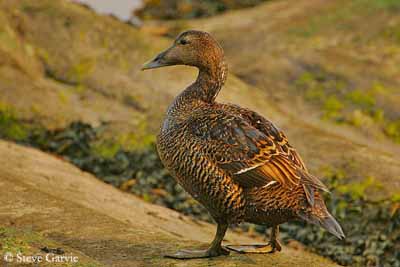
The nest is prepared by female. It is a shallow depression which interior is lined with materials found in the surrounding, and down from the female’s body. It is situated on the ground, sheltered by rock or some vegetation, occasionally in the open. If the male remains with her, it defends her from rivals and predators such as gulls and Ravens.
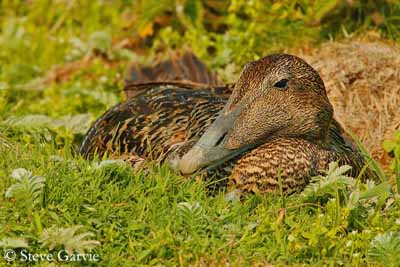
Female lays 4-5 eggs, one egg per day. Incubation lasts about 25-28 days by female alone. The downy chicks are brown above and whitish below, and leave the nest within 24 hours. They are able to feed themselves, and can dive after one hour in the water. They fledge between 65 and 75 days, and can perform their first flight at this moment.

The chicks of more than one brood often accompany one female, or large groups may gather and are attended by several females.
During the fall and the winter migrations, the youngs travel together and often arrive before adults on their wintering areas.

DIET:
The Common Eider feeds especially on bi-valves molluscs such as mussels and periwinkles (Littorna littorea), but it also consumes abundantly univalve molluscs, echinoderms, larvae of aquatic insects and crustaceans.
It also may take small quantities of vegetable matter such as algae, grasses, sedges…
The Common Eider feeds by diving down to the bottom, as in shallow marine waters or in small ponds in the tundra.
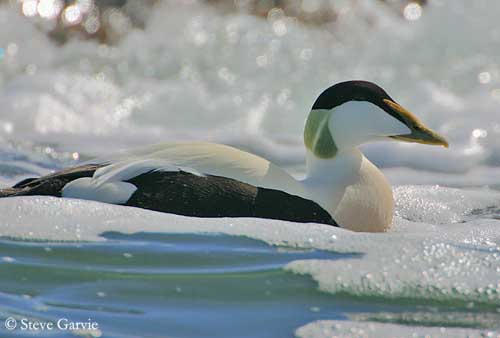
The Common Eider is very gregarious, living in large flocks all year round. They can come into harbours where we can see families swimming among the rocks and the seaweeds, or in the swell in sandy bays, but also beyond the breaking waves on rocky beaches. They often string out in long lines. At night, they gather in compact flocks, sometimes offshore or sheltered in creeks.
In late winter, some courtship can be observed, and we can hear the cooing and crooning calls of drakes in bright breeding plumage. Male performs the “upwards-tossing” of the head, “neck-stretching” and “wing-flapping”. Displays continue after mating, in order to maintain the pair-bonds.
FLIGHT:
The Common Eider often flies in long lines and low over water. It appears heavy and flies with slightly dropping head and neck.
During spring migrations, they travel in compact flocks, at speeds of about 60-70 km per hour. On the other hand, fall and winter migrations are slower.